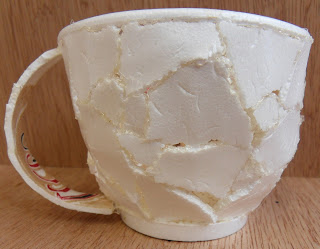Clare Twomey's work is themed around the influence of observed human interaction and political behaviour with focus on space, architectural interventions and the gallery as destination.
'Heirlooms' (Site Specific Installation)
- Reviewing the 'Heirloom' exhibition in 2004, Nicholas Rena suggested that Clare Twomey's work creates the appearance of an absent entity, questioning whether the artistic subject itself is somehow missing.
- 'This transfer of authority and power away from the aesthetic object and towards something increasingly purged does have meaning, and I believe that when an artist of Twomey's sensitivity finds herself offering such low-key and depleted things as other people's butter-dishes or another era's horseshoes, then we are dealing with a current artistic temper of almost excruciating honesty and reserve.'
- Twomey exhibits her works on the ground to be broken underfoot, or alternatively suspended weightlessly from above contrasting Marcel Duchamp's placing of an object upon a plinth. The objects are shy of asserting their significance as they have not been made nor chosen by the artist. Found and collected from car boot sales even the residual poetry of these lost and lonely pieces of domestic history is lost.
- 'Not the real thing now, bartered for or unearthed, but its ghost-white simulacra, cast mechanically - a poor cousin of the real thing, de-coloured, and in a final twist in the story of its abjection, sunk into the wall or into a puddle of earth at our feet.'
- Rena goes on to describe how 'Heirlooms' is missing the limitations of art i.e. the institute of the gallery's 'white cube' whilst also retaining purpose. In re-attuning our response to contact with something metaphysical, Twomey uses the visual language of simplified domestic things in order to communicate the fact that they are not devoid of all sacramental significance. In other words voicing a controversial opinion that the speed of mass production and consumption has not devalued the sentimentality attached to domestic every-day objects.
- Papanek was famously quoted stating that:
- "The only important thing about design is how it relates to the people."
- In terms of possession and ownership, Twomey's work supports Papanek's statement removing the so called 'sexed up' elements of design such as desirable (fashionable) colour, in order to direct emphasis onto the history and life of the object.
- Rena wrote: 'It is a fact too that galleries and museums, so often called the cathedrals of our day, are the stages for types of experience that are altogether less shared and demonstrative than those of cathedrals. There are no visual rituals attached to the viewing of art or of most types of contemporary spectacle, and the absence of celebration in contemporary art reflects this. The apparent passivity of present art is - to rephrase - a reflection of a certain cultural passivity. Twomey, I think, understands this. When I asked her where she thought colour in art had gone, or glory for that matter, she replied that these were perhaps 'no longer necessary'. Her reaction is at one with present culture.'





















































